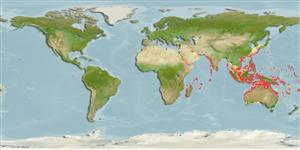Stephanometra indica (Smith, 1876)
| Native range | All suitable habitat | Point map | Year 2050 |

|
| This map was computer-generated and has not yet been reviewed. |
| Stephanometra indica AquaMaps Data sources: GBIF OBIS |
Upload your photos
Google image |
No photo available for this species.No drawings available for Mariametridae.
Google image |
No photo available for this species.
Classification / Names Common names | Synonyms | CoL | ITIS | WoRMS
| Comatulida | Mariametridae
Environment: milieu / climate zone / depth range / distribution range Ecología
; rango de profundidad 0 - 73 m (Ref. 81020). Tropical
Distribución Países | Áreas FAO | Ecosistemas | Ocurrencias, apariciones | Introducciones
Indo-West Pacific.
Length at first maturity / Tamaño / Peso / Age
Maturity: Lm ? range ? - ? cm
Occurs in tidepools (Ref. 101028). Subtidal on rocky outcrops at daylight (Ref. 102838). It is usually cryptic under rubble and at the reef during the day (Also Ref. 129602); it gets active at dusk, crawling to exposed perches and spreading its arms in a biplanar posture (Ref. 101028). Also found under dead and living corals (Refs. 100368, 129602). Suspension feeder (Ref. 68823).
Life cycle and mating behavior Madurez | Reproducción | Puesta | Huevos | Fecundidad | Larva
Members of the class Crinoidea are gonochoric. During spawning, the pinnule walls rupture and the eggs and sperms are shed into the seawater. Life cycle: Embryos elongate into free-swimming larvae (doliolaria) which later sink to the bottom where they metamorphose into stalked sessile crinoid.
Main reference
Referencias | Coordinador | Colaboradores
Putchakarn, S. and P. Sonchaeng. 2004. (Ref. 2534)
IUCN Red List Status (Ref. 130435)
CITES status (Ref. 108899)
Not Evaluated
CMS (Ref. 116361)
Not Evaluated
Threat to humans
Harmless
Human uses
| FishSource |
Herramientas
Más información
Países
Áreas FAO
Ecosistemas
Ocurrencias, apariciones
Introducciones
Stocks
Ecología
Dieta
componentes alimenticios
Áreas FAO
Ecosistemas
Ocurrencias, apariciones
Introducciones
Stocks
Ecología
Dieta
componentes alimenticios
Age/Size
Crecimiento
Length-weight
Length-length
Morfología
Larva
Abundancia
Crecimiento
Length-weight
Length-length
Morfología
Larva
Abundancia
Fuentes de Internet
BHL | BOLD Systems | CISTI | DiscoverLife | FAO(Publication : search) | Fishipedia | GenBank (genome, nucleotide) | GloBI | Gomexsi | Google Books | Google Scholar | Google | PubMed | Árbol de la vida | Wikipedia (Go, búsqueda) | Expediente Zoológico
Estimates based on models
Preferred temperature
(Ref. 115969): 24.4 - 28.9, mean 27.7 (based on 880 cells).


